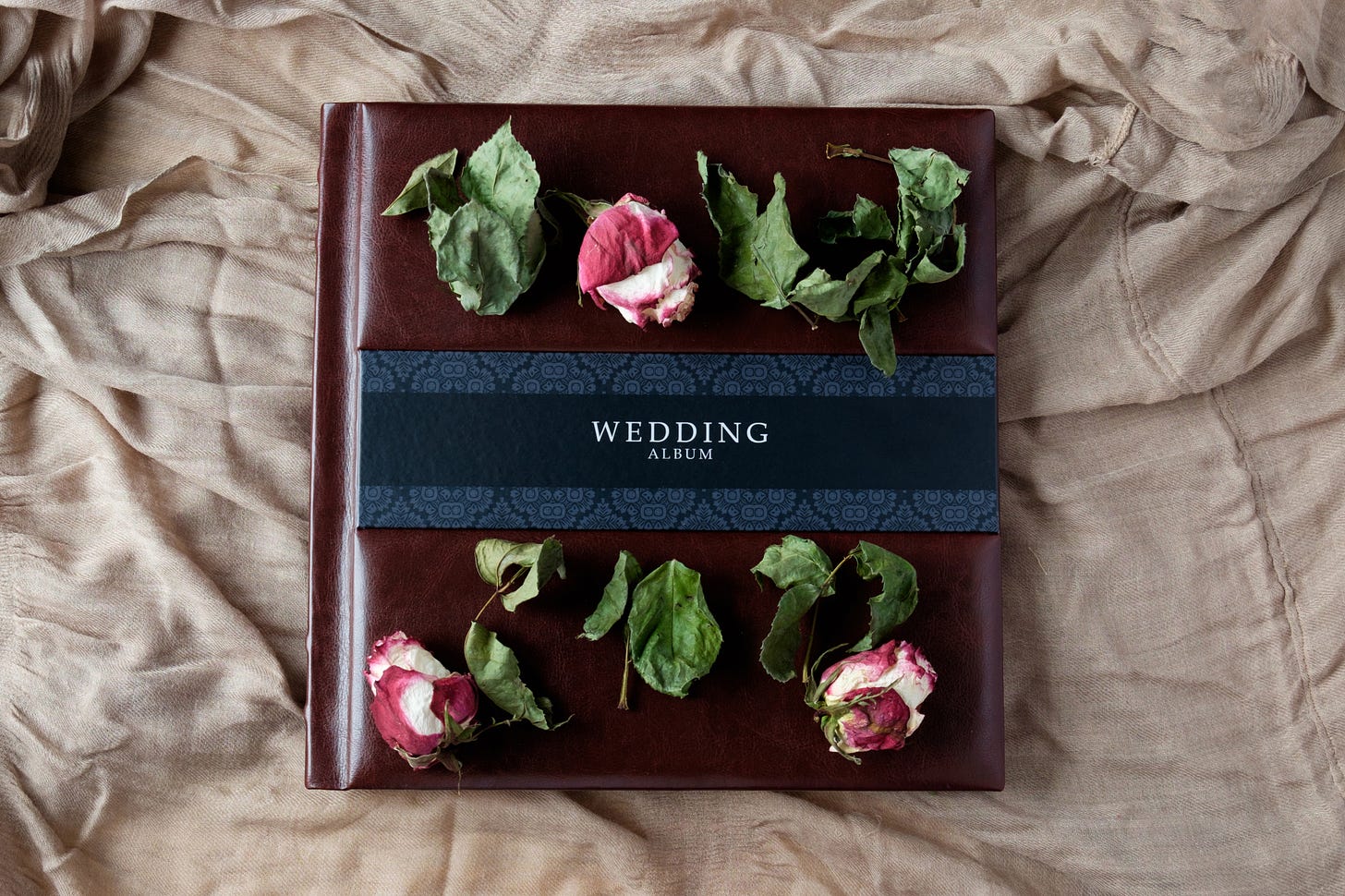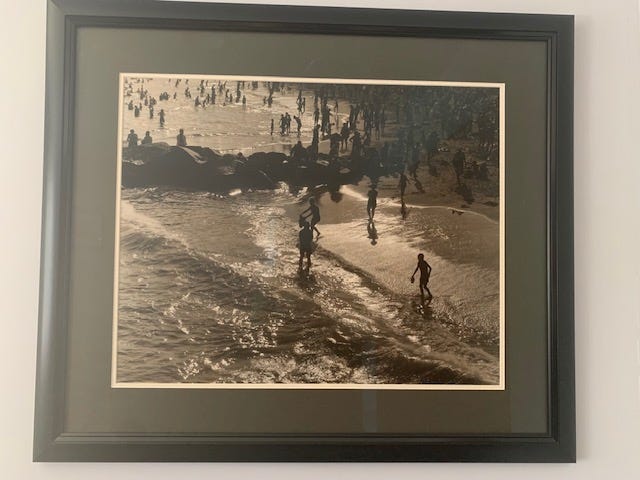Why I Tore Up My Wedding Album
My photo albums had to be destroyed, but the stories they told continue to inform my life
I ripped my wedding album apart last night. Page by page, tore out the photos that I cherish, left the repeats for refuse. I opened each leaf and pulled back the plastic that stuck to the adhesive onto which the pictures were mounted, wielding destruction that imbued me with a feeling of power. By the end, the giant white album—the spine of which had already cracked—was completely demolished. What was left was a three-inch tall stack of photos that I love, of people whom I love, taken by a friend whom I love, and the remnants of a day, 31 years ago, one of the happiest days of my life.
Here were my parents, young and still alive. Here were my college besties, who have been by my side for every major event, happy and sad, throughout my life. Here was my sister, looking grown up. Here were my new in-laws, happy and beaming, lovingly welcoming me into their family. Here were all the people who were important, blessing us as we stepped together onto the glass to begin our bright new life together.
But the album had to go—along with the 40 other photo albums that take up four shelves in my bookcases. I also tore apart the honeymoon album, the baby albums, the albums of our lives before we had children, the albums of our lives after each of our three children were born. There were our own baby albums, and albums with photos from our teen and young adult years, before we met and decided to share our lives. There were bar and bat mitzvah albums, travel albums—from trips we had taken together and those that my husband took when he traveled internationally for work. There was the scrapbook of the demolition and rebuilding of our home. And the album for the baby who lived five days.
The hard, desiccated shells now all sit in a pile by my table, looking war-torn. The pictures that sat in their pages are now aligned in neat piles, each album’s worth held together with a rubber band and a Post-it that notes the date span of the photos. They are being prepped for a new mode of existence: I am preparing to digitize my family’s memories.
-------------
Photographs connect us to our past and our future. They force us to stop and take a close look at what surrounds us. The photographer does this with the camera lens, framing a piece of the story revealing itself around them. The punctum—that small detail in the picture which captures the eye of the viewer and tells the story that is unfolding around the subject—is the key to photographic memory. We all look for the punctum in our lives, that which is the core to our story.
In my house growing up there was a large, black and white photo of Coney Island, taken in the 1930s. It had been taken by my grandfather, a well-known twentieth century photographer, who died when my mother was two. The frame that held the photo was gold and ornate and the glass was dusty, obscuring the extraordinary detail of the picture—the water lapping the beach shore, the people wading, the sunlight hitting the rock jetty, glinting in the afternoon heat. You can’t see the bathing garb of the people, removing any time stamp; it could have been taken yesterday, or in 1932. The same picture hung over the fireplace in the home of my cousins. There wasn’t a particular punctum in the photo itself, but its very existence told a story, and it connected in ways to my family that I wouldn’t understand for many years. When my mother died, I took the photo, had it reframed and hung it in my own living room, where it reminds me that I have a story to uncover.
-----------
My husband was our family archivist. He captured the most important moments in our lives together, as well as the mundane. He always had a camera with him; he died before the advent of the ubiquitous iPhone camera. I am grateful for the memories of our family captured in the albums he lovingly collated. He was a scrapbooker, and our albums include not only pictures but also cards and other ephemera that came as part of those times. Sonograms and baby announcements. Response cards from our wedding. Specs and plans from our house build. Sympathy cards when our infant son died.
When I was growing up, my mother documented our family life. I have vivid memories of my mother ordering copies of the best pictures to send to our grandmother and our aunt. When we visited their homes, those photos were sometimes out in frames, sometimes in other photo albums. It made us feel like we were part of something bigger than ourselves.
But those photos stopped short when I was 13 and my sister was eight. Our parents were fighting. Our mother no longer seemed interested in taking pictures. Once she moved out of our house, all photography ended. There is one picture each of our high school and college graduations.
My own family’s photo documentation didn’t stop when my husband died, six years ago, because we live in the age of the selfie. My three children take hundreds of pictures of themselves and their friends. I, too, use my phone to document my life. But when asked, my children are not interested in the photo albums. They see them as clunky and archaic. They’re not yet reviewing the past the way that I am. For them it is still too raw, too recent, too painful. They need to look forward.
As do I. Which is why the remnants of my wedding album now sit atop a pile of several dozen albums that have been similarly shredded over the course of an obsessive few days. I am leaving this house soon, and I cannot take these relics of my former life where I am going. Not only because they weigh too much and take up too much space, but also because I am leaving to start a new life with a new person. A person who loves me for everything I am, and knows that I had a life before we met, but who doesn’t need that life sitting on our shared bookshelves.
--------------
My mother never showed us any childhood pictures when we were growing up. Her mother died when she was in her early teens, and we grew up with no family lore, no family pictures. Only secrets to unravel. Only the knowledge that our grandfather had been a photographer. We didn’t see the irony in the lack of a pictorial story from our mother’s childhood, nor did we understand the pain she lived with for the rest of her life, being orphaned at 13. She blocked it out by focusing on the photographic annals of my sister and me, documenting what came after.
When my mother died, my cousin sent a spray of beautiful white flowers. We hadn’t been in touch since I was a child. We began to reconnect, slowly. Eventually I traveled to see her in Santa Barbara. She picked me up at the train station and we fell into each other’s arms, filled with love and delight. She drove me up the twisting roads into the mountains, where she and her husband live in a bungalow whose entryway is framed by riotous pink bougainvillea. As we stepped into the living room, whose windows open to mountains and ocean competing for the view, I gasped. My eyes were drawn immediately to the photo of Coney Island hanging on the wall. It looked smaller in this intimate space than it had during our childhoods, but there it was, marking the connection between my cousin’s life and mine. The hole in my life that had existed for decades—the hole my mother left in her wake, her physical and emotional absence, and the absence of her own family lore—felt filled by this one photograph, which was reaching across thousands of miles and generations to remind me of where I belonged.
----------------
My children will not have that empty hole needing to be filled. They have enough photographs for ten lifetimes. They have the stories. Someday, they will want to see our wedding pictures, and there they will be, available with a few clicks. They will want to see the joy in our faces on the days they were born, or on a family trip to Disneyland. At a school concert or a varsity baseball game. It will all be there, easily accessible from anywhere, a punctum to the memories that today are buried in pursuit of adulthood and other avenues. But it will call to them, and the gutting of the physical books that I undertook—hurting my back and hands as well as my heart in the process—will have been worth it.
Karen Paul is a writer in Takoma Park, MD, and the principal of Catalyzing Philanthropy, a fundraising and development consultancy. She is working on a memoir about her grief and trauma as a caretaker for a spouse with terminal brain cancer and her ensuing widowhood. She has had essays and short stories published in the New York Times/Modern Love, Washington Post, Lilith Magazine, Boston Globe, San Antonio Review, Pangyrus, Modern Loss, Motherwell, Red Wheelbarrow, Seltzer, Heartscapes and the two-volume pandemic collection, When We Turned Within. Karen graduated with an MFA from Vermont College of Fine Arts.






What a heart-wrenching and moving piece.
This is beautiful Karen. I could feel the emotion and pain in all of it and related so much to your story. Thank you for sharing.